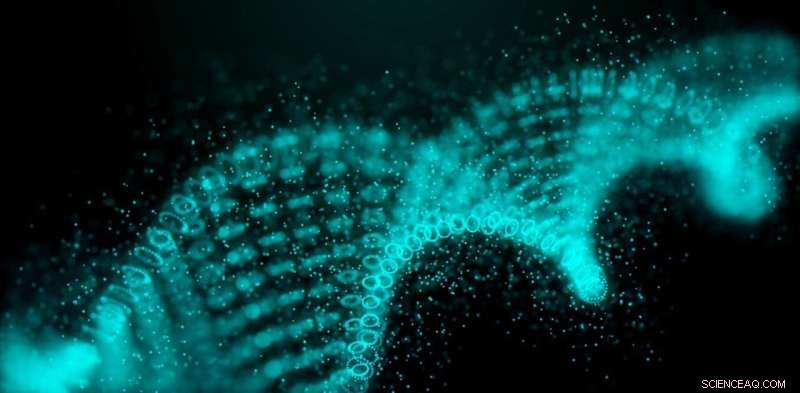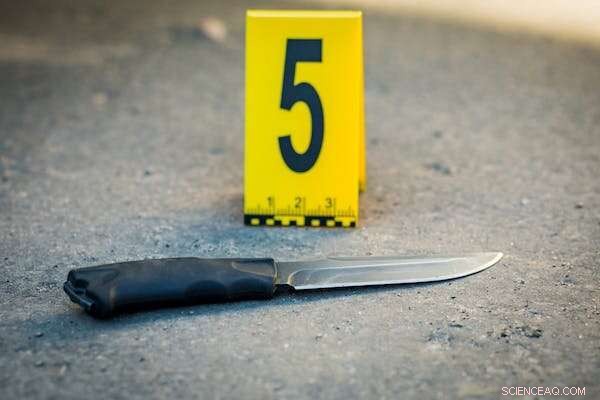
Credito:thinkhubstudio/Shutterstock
Il profilo del DNA è spesso nelle notizie. L'interesse pubblico si accende quando il DNA viene utilizzato per identificare un sospetto o resti umani, o risolve un caso freddo che sembra quasi dimenticato.
Molto occasionalmente, è nei media quando il processo non funziona come dovrebbe.
Allora, cos'è il profilo del DNA e come funziona, e perché a volte non funziona?
Una breve storia del profilo del DNA
Il profilo del DNA, come è noto dal 1994, è stato utilizzato nel sistema di giustizia penale dalla fine degli anni '80 ed era originariamente chiamato "impronta digitale del DNA".
Il DNA in ogni essere umano è molto simile, fino al 99,9% identico, in effetti. Ma stranamente, circa il 98% del DNA nelle nostre cellule non è correlato al gene (cioè non ha alcuna funzione nota).
Questo DNA non codificante è in gran parte composto da sequenze delle quattro basi che compongono il DNA in ogni cellula.
Ma per ragioni sconosciute, alcune sezioni della sequenza vengono ripetute:un esempio è TCTATCTATCTATCTATCTA dove la sequenza TCTA viene ripetuta cinque volte. Sebbene il numero di volte in cui questa sequenza di DNA viene ripetuta sia costante all'interno di una persona, può variare tra le persone. Una persona potrebbe avere 5 ripetizioni ma un'altra 6, o 7 o 8.
Ci sono un gran numero di varianti e tutti gli esseri umani cadono in una di esse. Il rilevamento di queste ripetizioni è la base della moderna profilazione del DNA. Un profilo DNA è un elenco di numeri, basato sulle sequenze ripetute che tutti abbiamo.
L'uso di queste brevi sequenze ripetute (il termine tecnico è "short tandem repeat" o STR) è iniziato nel 1994 quando il servizio di scienze forensi del Regno Unito ha identificato quattro di queste regioni. La possibilità che due persone prese a caso nella popolazione condividessero lo stesso numero di ripetizioni in queste quattro regioni era di circa 1 su 50.000.
Ora, il numero di sequenze ripetute conosciute è notevolmente aumentato, con l'ultimo test che ha esaminato 24 regioni STR. L'uso di tutte le regioni STR conosciute determina una probabilità infinitamente piccola che due persone casuali abbiano lo stesso profilo di DNA. And herein lies the power of DNA profiling.
How is DNA profiling performed?
The repeat sequence will be the same in every cell within a person—thus, the DNA profile from a blood sample will be the same as from a plucked hair, inside a tooth, saliva, or skin. It also means a DNA profile will not in itself indicate from what type of tissue it originated.
Consider a knife alleged to be integral to an investigation. A question might be "who held the knife"? A swab (cotton or nylon) will be moistened and rubbed over the handle to collect any cells present.

Swabbing an item left at a crime scene can easily yield enough cells to generate a DNA profile. Credit:Fuss Sergey/Shutterstock
The swab will then be placed in a tube containing a cocktail of chemicals that purifies the DNA from the rest of the cellular material—this is a highly automated process. The amount of DNA will then be quantified.
If there is sufficient DNA present, we can proceed to generate a DNA profile. The optimum amount of DNA needed to generate the profile is 500 picograms—this is really tiny and represents only 80 cells!
How foolproof is DNA profiling?
DNA profiling is highly sensitive, given it can work from only 80 cells. This is microscopic:the tiniest pinprick of blood holds thousands of blood cells.
Consider said knife—if it had been handled by two people, perhaps including a legitimate owner and a person of interest, yet only 80 cells are present, those 80 cells would not be from only one person but two. Hence there is now a less-than-optimal amount of DNA from either of the people, and the DNA profiling will be a mixture of the two.
Fortunately, there are several types of software to pull apart these mixed DNA profiles. However, the DNA profile might be incomplete (the term for this is "partial"); with less DNA data, there will be a reduced power to identify the person.
Worse still, there may be insufficient DNA to generate any meaningful DNA profile at all. If the sensitivity of the testing is pushed further, we might obtain a DNA profile from even a few cells. But this could implicate a person who may have held the knife innocently weeks prior to an alleged event; or be from someone who shook hands with another person who then held the knife.
This later event is called "indirect transfer" and is something to consider with such small amounts of DNA.
What can't DNA profiling do?
In forensics, using DNA means comparing a profile from a sample to a reference profile, such as taken from a witness, persons of interest, or criminal DNA databases.
By itself, a DNA profile is a set of numbers. The only thing we can figure out is whether the owner of the DNA has a Y-chromosome—that is, their biological sex is male.
A standard STR DNA profile does not indicate anything about the person's appearance, predisposition to any diseases, and very little about their ancestry.
Other types of DNA testing, such as ones used in genealogy, can be used to associate the DNA at a crime scene to potential genetic relatives of the person—but current standard STR DNA profiling will not link to anyone other that perhaps very close relatives—parents, offspring, or siblings.
DNA profiling has been, and will continue to be, an incredibly powerful forensic test to answer "whose biological material is this"? This is its tremendous strength. As to how and when that material got there, that's for different methods to sort out.